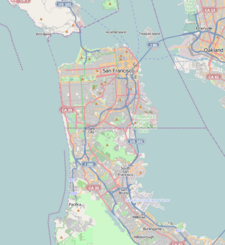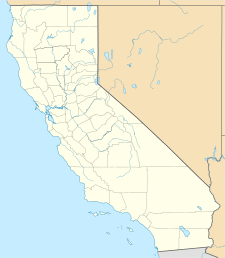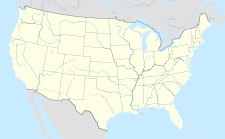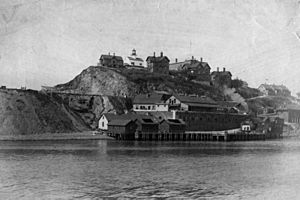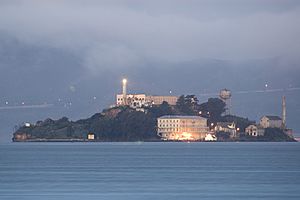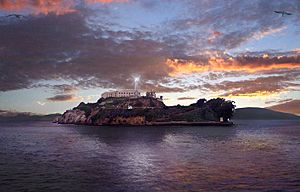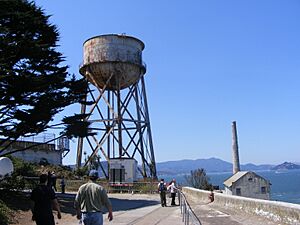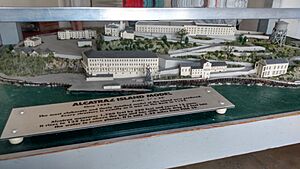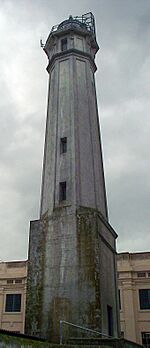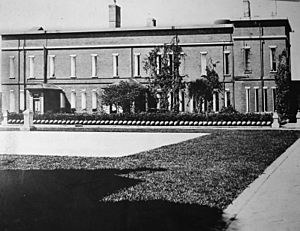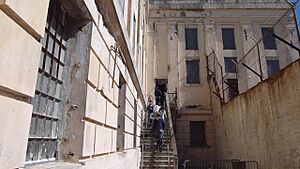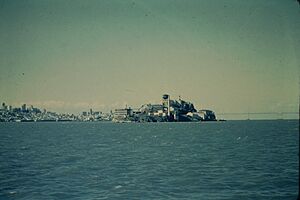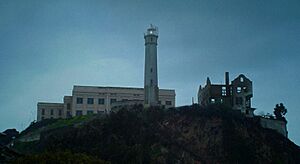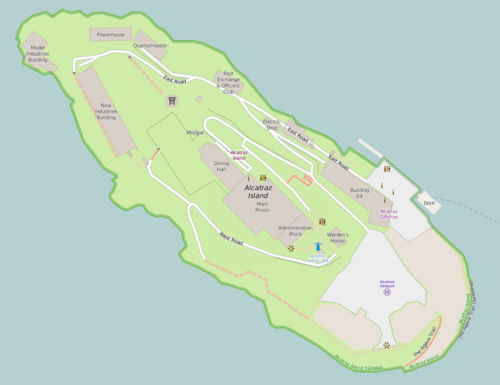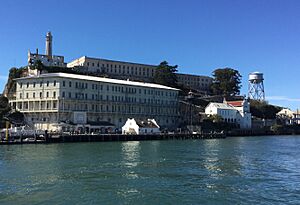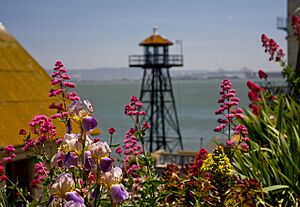Alcatraz Island facts for kids
Quick facts for kids Alcatraz Island |
|
|---|---|
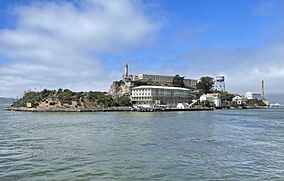
Alcatraz Island in San Francisco Bay from the east
|
|
| Location | San Francisco Bay, California, U.S. |
| Nearest city | San Francisco, California |
| Area | 22 acres (8.9 ha) |
| Established | 1934 |
| Governing body | National Park Service |
| Website | Alcatraz Island |
|
Alcatraz
|
|
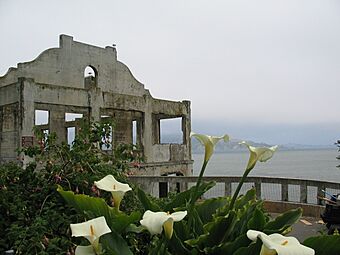
The Social Hall, destroyed by fire during the Native American occupation
|
|
| Area | 47 acres (19 ha) |
| Built | 1847 |
| Architect | U.S. Army, Bureau of Prisons; U.S. Army |
| Architectural style | Mission/Spanish Revival |
| NRHP reference No. | 76000209 |
| Significant dates | |
| Added to NRHP | June 23, 1976 |
| Designated NHLD | January 17, 1986 |
Alcatraz Island is a small island located about 1.25 miles (2 kilometers) off the coast of San Francisco in San Francisco Bay, California. It's close to the famous Golden Gate Strait. This island has a long and interesting history.
In the mid-1800s, Alcatraz was developed with a lighthouse, a military fort, and a military prison. Later, in 1934, it became a federal prison known as Alcatraz Federal Penitentiary. Escaping from Alcatraz was incredibly difficult because of the strong ocean currents and very cold water around the island. This made it one of the most famous and toughest prisons in American history. The prison closed on March 21, 1963.
Today, Alcatraz Island is a very popular tourist spot, attracting nearly 1.4 million visitors each year. From November 1969, a group of Native Americans occupied the island for over 19 months. They were protesting for Native American rights and drawing attention to their cause. In 1972, Alcatraz became part of the Golden Gate National Recreation Area. It was recognized as a National Historic Landmark in 1986.
The National Park Service now manages the island. Visitors can take a ferry from Pier 33 in San Francisco to explore its historic sites. Alcatraz Island features the abandoned federal prison, the oldest working lighthouse on the West Coast of the United States, old military fortifications, and natural areas. These natural areas include rock pools and a home for seabirds like western gulls, cormorants, and egrets. The island is about 1,675 feet long by 590 feet wide and its highest point is 135 feet above sea level. Its total area is about 22 acres.
Important places on the island include the Main Cellhouse (where prisoners lived), the Dining Hall, the Lighthouse, and the ruins of the Warden's House. Other landmarks are the Parade Grounds, Building 64, the Water Tower, and the Recreation Yard.
Contents
Exploring Alcatraz Island's Past
The first European to explore San Francisco Bay was Juan Manuel de Ayala, a Spanish naval officer, in 1775. He named a nearby island "La Isla de los Alcatraces," which means "The Island of the Gannets" or "Pelicans." This name later moved to the island we know as Alcatraz.
Over time, the Spanish name "Alcatraz" became widely used. In 1827, a French captain noted the island was "covered with a countless number of these birds." Today, California brown pelicans do not nest on the island. The Spanish built some small structures on Alcatraz.
Fort Alcatraz: A Military Stronghold
The island's first private owner was Julian Workman in 1846, who was supposed to build a lighthouse there. Later that year, John C. Frémont bought the island for the United States government. In 1850, President Millard Fillmore officially made Alcatraz a U.S. military area.
After California became part of the United States and the California Gold Rush began, the U.S. Army decided Alcatraz was a good place for coastal defenses. These defenses would protect San Francisco Bay. In 1853, work began to fortify the island, and by 1858, Fort Alcatraz was complete. The first group of about 200 soldiers arrived that year.
During the American Civil War (1861-1865), the island had many cannons, though not all could be used at once. It also stored weapons to keep them from falling into the wrong hands. Fort Alcatraz was used to hold prisoners during the war, including those who supported the Confederacy. However, its cannons were never fired at an enemy. The first working lighthouse on the West Coast was also built here.
Recent studies using special radar have found hidden structures beneath the old prison yard. These include a "bombproof" tunnel and ventilation ducts, still in surprisingly good condition. Archaeologists also found old ammunition storage areas and tunnels.
Because of the island's isolation and the cold, strong currents, Alcatraz started holding soldiers who committed crimes as early as 1859. By 1861, it was the main military prison for the Pacific region. It held Civil War prisoners of war.
After the Civil War, Alcatraz's defenses became outdated. The army then focused on using Alcatraz as a detention facility, which its isolated location made perfect for. In 1867, a brick jailhouse was built. By 1868, Alcatraz was officially a long-term prison for military prisoners. Some Hopi Native American men were also held here in the 1870s.
During the Spanish–American War in 1898, the prison population grew significantly. After the 1906 San Francisco earthquake, civilian prisoners were also sent to Alcatraz for safety. In 1907, it became the Western U.S. Military Prison.
Construction began in 1909 on the large concrete main cell block, which is still the island's most noticeable feature. It was finished in 1912. The old three-story barracks, called the Citadel, was mostly torn down to make way for the new cell block. Its first floor became a basement for the new prison, leading to stories of "dungeons." The military prison closed in 1933.
Alcatraz Federal Penitentiary: The Rock
The U.S. Department of Justice took over Alcatraz in October 1933, and it became a federal prison in August 1934. Alcatraz was designed to hold prisoners who caused problems at other federal prisons. On August 11, 1934, the first 137 prisoners arrived. They were escorted by many special agents and marshals.
Many of these prisoners were famous criminals. The prison had a staff of 155, including the first warden, James A. Johnston. The staff were very skilled in security. Surprisingly, some prisoners even asked to be moved to Alcatraz because it offered single cells and good food.
For 29 years, Alcatraz held some of America's most well-known criminals. These included gangsters like Al Capone and George "Machine Gun" Kelly. Also, Robert Franklin Stroud, known as the "Birdman of Alcatraz," was imprisoned here.
Alcatraz Island was also a home for the prison staff and their families. Correctional officers and their families lived in apartments on the island. Children attended a special school there. Many former residents later formed an association to share memories of growing up on "The Rock."
Why Alcatraz Prison Closed
Alcatraz closed as a prison in 1963 for several reasons. It was much more expensive to run than other prisons, costing nearly $10 per prisoner per day compared to $3 elsewhere. Also, fresh water had to be brought to the island weekly, about one million gallons. After half a century, the salt water had badly damaged the buildings.
Native American Occupation of Alcatraz
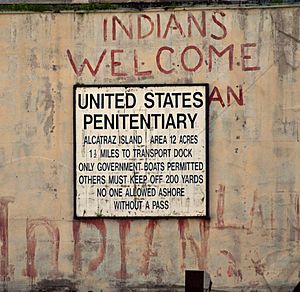
Alcatraz Island was first occupied by Native American activists on March 8, 1964, as a protest. A larger occupation began on November 20, 1969. A group called United Indians of All Tribes, mostly college students, occupied the island. They were protesting federal policies that affected American Indians.
The occupiers stayed on the island for almost two years. They wanted the island to become an Indian education, ecology, and cultural center. They claimed the island based on an old treaty and the "Right of Discovery." The occupation drew Native Americans from all over the country.
During the occupation, some buildings on Alcatraz were damaged or destroyed by fire, including the lighthouse keeper's home and the warden's home. The cause of these fires is debated. You can still see Graffiti from this time in many places on the island.
During this period, President Richard Nixon changed federal policy towards Native Americans. He established a new policy of self-determination, partly because of the attention the occupation brought. The occupation ended on June 11, 1971.
Alcatraz Under the National Park Service
In 1972, the National Park Service bought Alcatraz to create the Golden Gate National Recreation Area. President Richard Nixon approved funding for this. Since then, Alcatraz has been a popular tourist site and museum. It teaches visitors about its time as a federal prison. Operating costs remain a challenge for the island today.
In May 2025, there was a proposal to reopen the island's prison, but this idea did not move forward.
Alcatraz Island Landmarks
Part of the Golden Gate National Recreation Area since 1972, Alcatraz Island was listed on the National Register of Historic Places in 1976. In 1986, it received the highest recognition as a National Historic Landmark.
In 1993, the National Park Service created a plan to make more of Alcatraz accessible to the public. This allowed visitors to enjoy its beautiful scenery and observe its bird and animal life.
Major sites on the island include:
- Boat Dock
- Building 64
- Citadel
- Dining Hall
- Former Military Chapel (Bachelor Quarters)
- Helipad (FAA LID: CA27)
- Library
- Lighthouse
- Main Cellhouse
- Model Industries Building
- Morgue
- New Industries Building
- Officers' Club
- Parade Grounds
- Power House
- Recreation Yard
- Wardens House
- Water Tower
Island Development and Preservation
American Indigenous groups, like the International Indian Treaty Council, sometimes hold ceremonies on the island. These include "Sunrise Gatherings" on Columbus Day and Thanksgiving Day.
Around 2007, a group proposed tearing down the prison to build a peace center. This idea was estimated to cost $1 billion. However, voters rejected the proposal in February 2008, with 72% voting against it. Many felt Alcatraz's history was too important to destroy.
The coastal environment of San Francisco Bay has caused buildings on Alcatraz to wear down. Since 2011, the National Park Service has been making major renovations. These include installing solar panels, stabilizing slopes, and repairing the cell house walls.
Alcatraz is now one of San Francisco's main tourist attractions, drawing about 1.7 million visitors annually. Visitors arrive by ferry from Pier 33. The old prison buildings are being preserved and made safer. More areas of the island are also being opened to the public. During the COVID-19 pandemic, the island was closed for over a year but reopened in March 2021.
Art on Alcatraz
Alcatraz has hosted several art exhibitions. In 2014, Chinese artist Ai Weiwei created an exhibition called "@Large." It explored human rights and freedom of expression, featuring Lego portraits of famous political prisoners. In 2016, Nelson Saiers used math and prison slang in an installation to highlight long prison sentences.
Alcatraz Island's Wildlife and Plants
Animal Habitats and Life Cycle
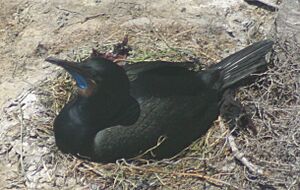
- Cisterns: These moist areas are important for California slender salamanders.
- Cliff tops: The northern cliff tops are key nesting and roosting spots for birds.
- Powerhouse area: This steep area with native grasses provides a home for deer mice.
- Tide pools: These unique pools, created by quarrying, are home to various small sea creatures.
- Western cliffs: Rising nearly 100 feet, these cliffs are nesting and roosting sites for seabirds like pigeon guillemots and cormorants. Harbor seals are sometimes seen on a small beach below.
- Parade grounds: This area, once a hillside, is now a habitat and breeding ground for black-crowned night herons, western gulls, and slender salamanders.
- Agave Path: This trail, named for its dense agave plants, provides a nesting habitat for night herons.
- In recent years, from August to October, many cormorant flies can be found on the island.
Plant Life and Gardens
Gardens planted by military families and later by prison guards were neglected after the prison closed in 1963. After 40 years, these gardens are being restored by staff and volunteers. Funding comes from the Garden Conservancy and the Golden Gate National Parks Conservancy.
The overgrown gardens had become a sanctuary for many birds. Now, bird habitats are protected, while many gardens are being brought back to their original state. Workers found many original plants still growing, some over 100 years old. Rare heirloom rose hybrids, including a Welsh rose thought to be extinct, have been rediscovered. Many types of roses, succulents, and geraniums grow among apple and fig trees, sweet peas, and wild native grasses.
Gallery
-
A panorama of Alcatraz as viewed from San Francisco Bay, facing east. Sather Tower and UC Berkeley are visible in the background on the right.
See also
 In Spanish: Isla de Alcatraz para niños
In Spanish: Isla de Alcatraz para niños
- Asinara
- Cellular Jail
- Château d'If
- Devil's Island
- Fort Denison
- List of islands of California
- Robben Island
- San Lucas Island
- Alligator Alcatraz


